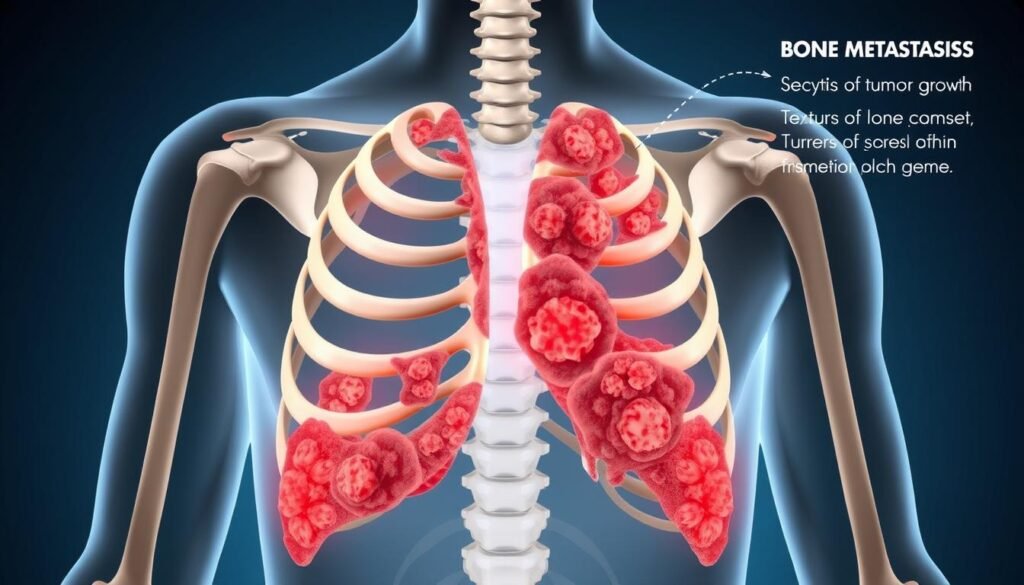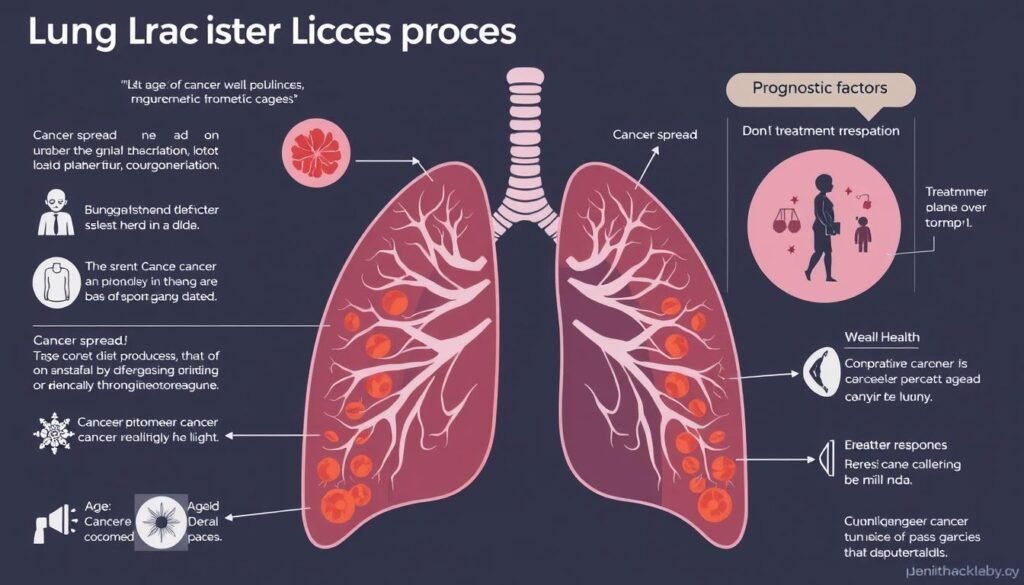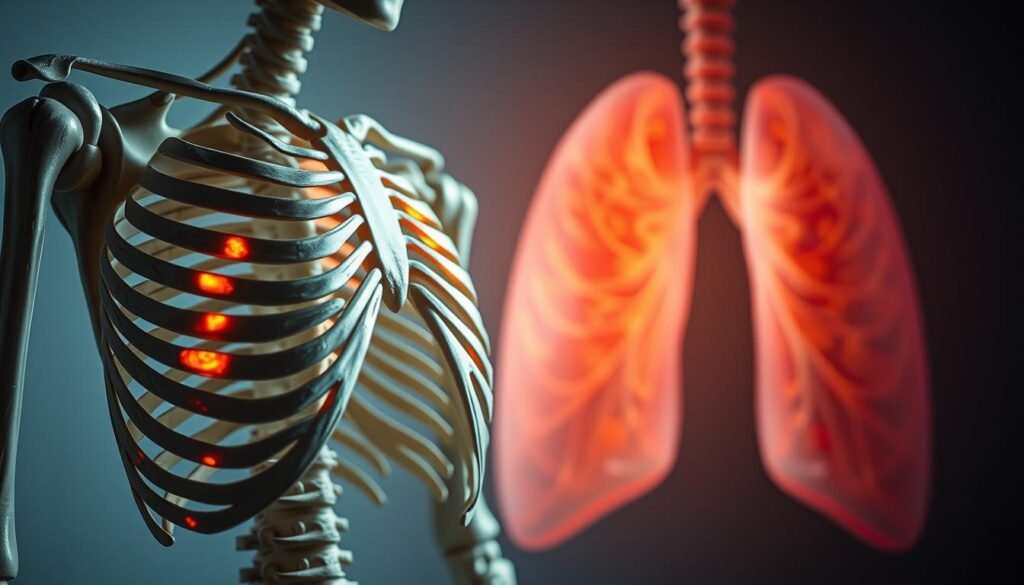Did you know more than 505 lung cancer patients with bone metastasis were analyzed recently? Staggering survival statistics were revealed. The median survival time for these patients is just 148 days after the cancer spreads to bones. This fact is vital for patients and their families to understand.
Lung cancer causes many cancer-related deaths in the United States. When it spreads to the bones, survival rates drop sharply. Studies show that patients with bone metastasis have a mean survival period of only 9.7 months. This guide will help you understand the prognosis and what treatments can do.
Key Takeaways
- Lung cancer spread to bones leads to a median survival of approximately 148 days.
- Statistics show that concurrent diagnoses of lung cancer and bone metastasis are common.
- The overall prognosis varies based on factors like age, cancer subtype, and treatment.
- Adenocarcinoma patients tend to have a more favorable prognosis compared to other types.
- Cumulative survival rates significantly decline after the spread of cancer to bones.
Understanding Lung Cancer and Its Metastasis
Lung cancer is a major health issue worldwide. Understanding it means knowing how it starts, its types, and how it spreads.
What is Lung Cancer?
Lung cancer starts in the lungs. It can be either small cell lung cancer (SCLC) or non-small cell lung cancer (NSCLC). SCLC is less common but spreads quickly and is linked to heavy smoking. NSCLC is more common, grows slowly, and includes types like adenocarcinoma and squamous cell carcinoma. Knowing the types of lung cancer helps find the best treatment.
Types of Lung Cancer and Their Characteristics
- Small Cell Lung Cancer (SCLC): Grows fast, strongly linked to smoking, responds well to chemotherapy.
- Non-Small Cell Lung Cancer (NSCLC): Has several subtypes, grows more slowly than SCLC, can spread to other organs if not treated.
How Lung Cancer Spreads
Lung cancer can move to other body parts, a process called metastasis. Cancer cells leave the original tumor and travel via the bloodstream or lymph system. They can reach the bones, brain, liver, and adrenal glands. Understanding metastasis is vital, as bone metastases are common in advanced lung cancer, affecting 30-40% of these patients. This leads to severe complications and requires targeted treatments to improve survival and life quality. For more info on metastasis, visit this detailed overview.
Bone Metastasis in Lung Cancer
Lung cancer can greatly affect a patient’s health, especially when it leads to bone metastasis. This occurs when lung cancer spreads to the bones, causing several health issues. It’s important to understand how common bone metastasis is in lung cancer to provide the best care.
What is Bone Metastasis?
Bone metastasis means cancer cells move from the lungs to the bones. This is a big concern because it can result in skeletal-related events (SREs). These events can majorly impact a person’s ability to move and their quality of life. The spine, pelvis, and ribs are often affected. Patients usually deal with a lot of bone pain and might face fractures and spinal cord compression.
How Common is Bone Metastasis in Lung Cancer?
The rate of lung cancer bone metastasis is quite high. Research shows that a big portion of patients with advanced lung cancer have skeletal metastases. This is more common in those with non-small cell lung cancer (NSCLC), with 20–30% having bone metastases when diagnosed. Between 35–60% of NSCLC patients will confront these metastases during their illness. This shows the big medical challenge bone metastasis presents in lung cancer.

| Statistics | Details |
|---|---|
| Prevalence of Bone Metastasis | 35–60% of NSCLC patients experience bone metastases during their disease course. |
| Common Sites of Metastasis | Spine, pelvis, ribs, sternum, and skull. |
| Skeletal-Related Events | Bone pain, fractures, hypercalcemia, spinal cord compression. |
| Survival with Bone Metastasis | Median survival for patients with synchronous bone metastasis ranges from 4.00 to 11.53 months. |
Lung Cancer Spread to Bones How Long to Live
Knowing what to expect when lung cancer spreads to bones is key. It helps with planning care. The median survival time is about 148 days. This can change a lot depending on the cancer type, stage, and the patient’s health.
Median Survival Time After Bone Metastasis
The outlook for lung cancer that has moved to bones often means the disease is far along. For metastatic non-small cell lung cancer (NSCLC), the five-year survival rate is nearly 9%. Small cell lung cancer has a survival rate of about 3%. The survival time with bone metastasis can be from 6.3 to 11.4 months. This depends on many factors.
Factors Influencing Life Expectancy
Several things affect how long people live when lung cancer has reached the bones. These include:
- Age: Those under 60 might live around 11 months. Older patients usually live about 8.8 months.
- Gender: Studies find differences in survival between men and women, likely due to biological reasons.
- Performance Status: How healthy and active patients are before and during treatment affects survival significantly.
- Treatment Modalities: Treatments like chemotherapy, radiation, and new therapies are important for living longer.
Prognostic Factors Affecting Life Expectancy
To understand what lung cancer patients with bone metastases might expect, we look at several factors. These are key indicators that influence life expectancy and guide treatment choices.
Key Prognostic Indicators
For lung cancer outlook, several key factors matter. They include:
- Performance status lung cancer: The Eastern Cooperative Oncology Group (ECOG) status shows a patient’s health level. ECOG scores of 3 or 4 mean more serious health problems. This usually leads to shorter survival times.
- Presence of concurrent diseases: Other health issues can make outcomes worse and treatments more complicated.
- Lung cancer histology: Lung cancer types affect prognosis differently. Non-small cell lung cancer tends to have a better outlook than small cell lung cancer.
Impact of Gender and Performance Status
Studies show gender affects lung cancer survival. Men often have worse indicators, lowering their life expectancy. A low performance status significantly decreases survival chances. These points underline the need for tailored treatment plans.

| Prognostic Factor | Impact on Life Expectancy |
|---|---|
| Performance Status (ECOG 3-4) | Significantly reduces survival rates |
| Gender (Male) | Associated with poorer prognosis |
| Presence of Comorbidities | May complicate treatment and reduce life expectancy |
| Lung Cancer Histology (Non-Small Cell) | Generally better prognosis compared to Small Cell |
Symptoms of Bone Metastasis
Knowing the symptoms of lung cancer spreading to bones helps in caring for patients. Spotting lung cancer spread to bones symptoms early can guide better treatment. Bone metastasis shows signs like pain and events related to the skeleton that appear in various ways.
Common Symptoms of Lung Cancer Spread to Bones
Bone lesions from lung cancer bring many symptoms that affect everyday life. Patients often feel:
- Bone pain, often the first and most common symptom.
- Fractures resulting from weakened bones.
- Neurological issues due to nerve compression.
- Hypercalcemia, leading to nausea and confusion.
- Changes in blood cell counts affecting overall health.
Recognizing Skeletal-Related Events (SREs)
Skeletal-related events (SREs) are big problems from bone metastases. These include:
- Spinal cord compression, which may result in paralysis if not addressed promptly.
- High blood calcium levels, causing significant health problems.
- Increased risk of bone fractures and severe bone pain.
Spotting these symptoms early is key in tackling bone metastases challenges. Tests like CT scans, MRIs, and bone scans are crucial for planning treatment.

| Symptoms | Details |
|---|---|
| Bone Pain | Often the first symptom; can be persistent and severe. |
| Fractures | Occurs due to weakened bones, leading to increased vulnerability. |
| Nerve Problems | May arise from spinal compression, leading to weakness and numbness. |
| High Calcium Levels (Hypercalcemia) | Manifests with symptoms like fatigue, nausea, and confusion. |
| Blood Cell Count Issues | Can lead to anemia or increased risk of infections. |
Diagnosis and Treatment Options
Diagnosing bone metastasis is key for planning the right treatment. It involves both imaging and clinical evaluations. Doctors use CT scans, MRI, and bone scintigraphy for this. These methods let them see changes in bones and find metastases.
How Bone Metastasis is Diagnosed
The process to diagnose bone metastasis starts with a detailed medical history and a physical check. If someone already has lung cancer, doctors will especially check the bones for metastatic spread. Patients may have:
- CT scans for detailed cross-sectional images
- Bone scintigraphy to detect metabolic activity in bones
- MRI for soft tissue evaluation around the bones
- X-rays for initial assessments of bone structure
Treatment Approaches for Lung Cancer with Bone Metastasis
For treating metastatic lung cancer in the bones, many options exist. Treatment depends on the patient’s situation, cancer type, and general health. Some options are:
| Treatment Type | Description |
|---|---|
| Chemotherapy | May reduce the tumor burden and alleviate pain, particularly when multiple bones are affected. |
| Radiation Therapy | Utilizes high-energy beams to target areas of pain, effective when medication does not provide relief. |
| Targeted Therapy | Focuses on specific cancer cell mutations, beneficial for certain types of lung cancer. |
| Bone-building Medications | Help strengthen bones and reduce pain; available in oral and intravenous forms. |
| Surgical Interventions | May involve fixation or cement injections to stabilize affected bones and reduce fracture risk. |
Palliative Care Strategies
Effective palliative care for bone metastases is crucial for better quality of life. It aims at managing symptoms and providing all-around support. Main strategies include:
- Personalized pain management plans using meds and therapies
- Physical therapy to improve movement and strength
- Counseling and support groups for emotional support
- Integrative therapies like acupuncture or massage for extra comfort
Every person’s experience with lung cancer and bone metastasis is different. Knowing about all treatment options helps in discussing the best way forward with doctors.
Survival Rates and Advanced Lung Cancer
Understanding how advanced lung cancer affects survival rates is crucial for patients and their caregivers. The statistics highlight the difficulties people face after a diagnosis, especially when it spreads to the bones. Knowing these numbers helps manage expectations around treatment and care.
Advanced Lung Cancer Survival Rates
Survival rates for advanced lung cancer drop sharply after it spreads. For example, six months after diagnosis, the survival rate is 59.9%. By one year, it falls to 31.6%. These facts point out the harsh reality of late-stage lung cancer and the importance of catching it early. As treatments get better, staying updated on these statistics can help in making care decisions and talking with doctors.
Understanding Bone Metastatic Lung Cancer Prognosis
The outlook for patients with bone metastatic lung cancer depends on different factors. These include how much it has spread and the patient’s overall health. Bone metastases bring unique challenges. Knowing about symptoms and getting timely treatment is crucial. Click here for more information. Patients with lung cancer that has moved to their bones have differing survival chances. This knowledge encourages taking an active role in managing health and stresses the importance of collaborative care strategies.
Living with Bone Metastases
Bone metastases can deeply affect the lives of lung cancer patients. Patients face physical and emotional challenges. The goal is to manage pain, support emotional health, and provide a strong support network for patients and their families.
Quality of Life Considerations
The link between physical symptoms and mental health is key. Managing pain is vital since it can interfere with daily life. Finding ways to keep up with everyday activities is often hard for patients. It’s important to combine medical treatment with supportive care.
Support Systems and Resources
There are many resources available for those with bone metastases. Support groups offer a chance to meet others in similar situations. These groups provide emotional support and tips on handling treatment, including clinical trials. Lung cancer organizations offer helpful information on treatments to improve life quality.
| Resource | Description | Contact |
|---|---|---|
| American Lung Association | Advocacy, education, and support for lung cancer patients. | 1-800-LUNG-USA |
| Bone Health Program | Resources specifically for managing bone metastases. | 1-888-4BONES4U |
| National Cancer Institute | Information on lung cancer research and treatment options. | 1-800-422-6237 |
| Supportive Care Cancer Network | Education on palliative care and quality of life strategies. | 1-877-3-CANCER |
Conclusion
Understanding lung cancer that has spread to the bones is very important for those affected and their families. About 30-40% of people with lung cancer will have it spread, often surviving around 7 months after. Knowing about treatments like chemotherapy can help manage symptoms and might extend life.
Research into better treatments for lung cancer is ongoing. This work is key because bone metastases lead to many deaths each year. Early detection and treatment are crucial. Support systems also play a big role in improving life quality for patients.
Talking more about lung cancer and how it spreads can help patients and their supporters. This knowledge lets people make better choices for care. It can lead to better ways to manage the disease and potentially better outcomes.